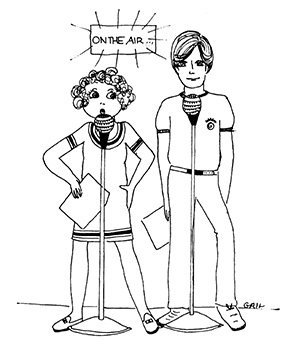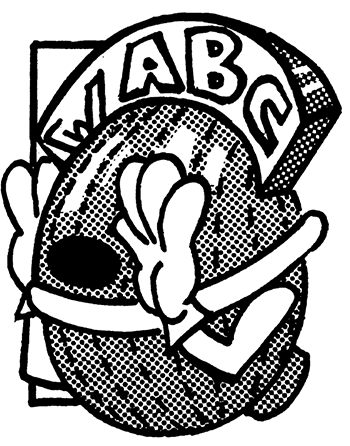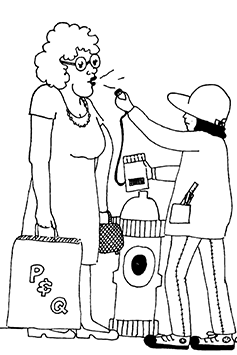Listening to Audio Pedagogies
Introduction
With the rise of podcasting and other digital audio technologies in the twenty-first century, we’ve seen a great resurgence of attention to the role of audio technologies in the teaching of writing. This most recent sonic boom in the field was in many ways kicked off by a 2006 special issue of Computers and Composition on “Sound as/in Composition Space” (Ball and Hawk 2006). In the years following, a wide range of print and digital scholarly articles, books, and journal issues have argued that paying more attention to digital sonic technologies can enable us to reimagine the teaching of writing, rhetoric, and literacy (Ahern 2013; Bowie 2012; Ceraso 2018; Comstock and Hocks 2006; Davis 2011; Danforth, Stedman, and Faris 2018; Dangler, McCorkle, and Barrow 2007; Hocks and Comstock 2017; Jones 2010; Selfe 2009).
In addition to pedagogical applications of digital audio, we've also witnessed a rise of digital audio scholarship in the field. Many contemporary writing teachers are tuning into such engaging scholarly podcasts as This Rhetorical Life; Rhetoricity; Not Your Mama’s Gamer; Plugs, Play, Pedagogy; and Phantom Power, to name but a few on the scene. We’ve also seen a proliferation of special digital journal issues and born-digital books that are making extensive use of digital audio content (Bowie 2012; Davis 2011; Danforth, Stedman, and Faris 2018; Stone and Ceraso 2013; VanKooten 2017). These emerging forms of digital audio scholarship work to instantiate the common metaphor of scholarship-as-conversation by enabling their many listeners to engage with multiple spoken voices in dialogue about many of the most pressing issues in the study and teaching of writing and rhetoric today. In this chapter, we seek to further contribute to this digital audio boom in scholarship by composing the majority of our argument via two connected podcast episodes.

Although much of the field’s scholarship on audio writing pedagogies has highlighted the unique affordances of digital tools, numerous scholars have also argued compellingly that we must situate our work with digital composing in relation to much longer and more expansive histories of sound —that we need to pay more attention to histories and contemporary practices of music performance, underground radio, experimental sound art, and other forms of acoustic design (Alexander 2015; Banks 2011; Bessette 2016; Ceraso 2018; Hawk 2018; Hocks and Comstock 2017; Sirc 2002). For the most part, however, these scholars’ historicizing of digital audio pedagogies has centered on recovering audio composing traditions outside the English classroom—leaving in place the commonplace assumption that teaching audio composing in English classrooms is a new phenomenon brought about largely by the digital audio revolution.
Even when scholars have turned specifically to exploring the history of aurality in English classrooms, they have focused primarily on critiquing how the field of English has historically failed to engage meaningfully with audio composing technologies. For example, Cynthia Selfe’s powerful CCC article, “The Movement of Air, the Breath of Meaning,” elucidated and critiqued why and how twentieth-century composition pedagogies narrowed their focus to print-based texts in ways that ignored the crucial aural dimensions of rhetorical practice. Although Selfe usefully pointed to a substantial counter-history of English teachers employing analog audio recorders as tools to respond to student writing, she largely passed over the broader history of how English teachers engaged students in producing radio programs and other sonic texts in the 1930s and other eras. Similarly, Palmeri’s Remixing Composition considered how sonically inflected 1960s and 1970s scholarship on voice, critical pedagogy, and language diversity might productively inform contemporary approaches to teaching digital audio composing—but Palmeri, too, passed over the longer expansive history of audio production happening mostly in K-12 classrooms.
While composition and rhetoric scholars have largely ignored the history of radio and other analog sound technologies in schools, scholars of educational technology have begun the important work of recovering expansive histories of radio instruction in K-12 and university settings (Bianchi 2008; Cuban 1986; Krause 2019; Saettler 1990). In particular, historians of educational technology have pointed to the importance of revisiting the “School of the Air” movement in the 1920s, 1930s, and 1940s—a network of local, state, and national radio broadcasters sponsored by a range of governmental and corporate organizations who created and distributed educational radio content for use during school hours (Bianchi 2008). In many ways, the School of the Air movement emphasized the power of radio to enable expert lecturers to reach wide audiences of students at a distance, making arguments for technologically enhanced educational access that are strikingly similar to claims often made about MOOCs and other forms of online education today. For example, in his extensive history of Schools of the Air, William Bianchi asserted that there were
many striking parallels between the widely enthusiastic predictions of ground-shaking, life-altering effects made on behalf of the Internet throughout the 1990s and the similarly exuberant claims made in the early days of radio. According to excitable proponents, [. . .] radio would foster world peace, bring about informed democratic government, and end poverty. But its greatest value, they asserted, would be as a tool for education. It would draw the people of the word together into giant educational village. (Bianchi 2008, 2)
In our efforts to recover 1930s radio pedagogies, we draw upon and extend Bianchi’s critical view of the hyperbolic claims about education at a distance made by early School of the Air proponents. When we remember the largely unrealized transformational claims that were once made for radio as an educational medium, we can become more critical of the idea that any one new technological innovation will automatically democratize established structures of educational inequality.
Although we see value in historical work on the School of the Air movement, we also suggest that Bianchi and other historians of radio in education (Cuban 1986; Saettler 2004) have focused too narrowly on recovering only the ways in which radio functioned as a kind of “textbook of the air” (Cuban 1986, 20)—positioning radio almost entirely as a medium for delivering aural instruction to students. Yet, the “School of the Air” movement was only one slice of a wider discussion that was happening about radio education in the 1930s, and we contend that turning to the English Journal archive offers a more robust view of the possibilities and pitfalls of radio as an educational medium.

While some 1930s English Journal authors extolled the virtue of bringing educational broadcasts into the English classroom, the journal also played host to a much more expansive and noisy conversation about the radical potential of popular radio listening and critical radio production to transform English classrooms. Recognizing that many formal daytime educational broadcasts were not particularly engaging for students, English teachers argued for the value of engaging students in critically analyzing the popular radio programs they were already listening to outside of school hours. And, even more radically, teachers increasingly asserted that students would develop a more critical understanding of radio as a medium if they gained experience making their own radio programs. We contend that this more active, production-centered history of radio English pedagogies is especially crucial for us to recover in our current moment when new technological developments are once again causing teachers to experiment more widely with audio production in our classrooms and in our scholarly communities.
By turning our ears towards the noisy sonic history of K-12 English pedagogies, this chapter works to reveal how listening closely to the history of past audio writing pedagogies can enable us to critically reimagine how we are engaging with digital audio in the present (and the future). While our graphs of radio articles in the last chapter revealed some broad trends—for instance, radio production pedagogies boomed in the 1930s and then mostly waned after that time—our sonic case studies in this chapter delve into exploring some of the possible causes of the trends we observed in the graphs. We also consider more specifically what contemporary teachers might have to learn from critically recovering past pedagogical approaches to engaging audio technologies. In addition to listening closely to the voices of English teachers at the forefront of the 1930s radio production pedagogy boom, we also turn our attention to some smaller micro-trends in our corpus that were barely perceptible in the graphs: (1) the mid-century movement to employ audio recorders for speech correction and grading; and (2) the small resurgence of radio pedagogies that occurred in relation to proliferating mobile audio tape recorders in the 1970s, 1980s, and 1990s.
The core of this chapter consists of two episodes of a scholarly podcast about histories of sonic pedagogies. In the first episode, “English Via the Airwaves,” we listen closely to the voices of 1930s English teachers who advocated for diverse forms of radio production in the classroom. We begin by considering the reasons why teachers became so drawn to radio work in this era, and then work to elaborate on some aspects of past radio production pedagogies that are well worth recovering, as well as some problematic pedagogical practices that should be avoided. This podcast deliberately blends contemporary podcast aesthetics with 1930s radio genre features, seeking to demonstrate how contemporary digital scholarship might draw inspiration from older media genres.
Before turning to the second podcast episode, we offer a short alphabetic case study of mid-century audio recorder pedagogies. While interest in having students make radio programs largely waned in the forties, fifties, and sixties, we uncover a substantial history of English teachers making use of a range of analog recording technologies for “correcting” student speech and evaluating student writing. Teasing out the ways in which mid-century audio pedagogies were constrained by corporate “literacy sponsors” (Brandt 2001) who positioned audio recorders as tools of surveillance and control, we ultimately argue that recovering the history of past corporate-inflected, audio writing pedagogies can help us turn a critical eye on many of the corporate educational technologies that promise to make our lives more efficient today.

After this critical detour, we debut our final podcast episode “The Afterlives of Radio,” in which we explore how the rise of mobile audio tape recorders and players inspired a modest resurgence of interest in audio production pedagogies in English classes—including the making of “mock” radio programs of decades past. As we tease out the ways in which radio was discussed in these later twentieth century articles, we ultimately seek to complicate and extend Hawisher and Selfe’s important finding that “media literacies have lifespans” (Hawisher and Selfe 2004). While our graphs might lead us to tell a simple lifespan story of radio’s move from birth to death, our podcast suggests that old media rarely truly die—rather, they become reanimated as they interact with other newer media in ever-shifting ecologies. Rather than seeing the older stages of a media lifespan as a time of decline or death, we instead seek to demonstrate how recovering and reanimating older media forms such as radio can help us reimagine digital audio pedagogies—a point we flesh out further in the “Pedagogical Inspirations” section that concludes this chapter. As you listen in our podcast episodes to our voices in dialogue with the voices of our talented cast of voice actors (and an array of quirky sound effects), we invite you to consider how radio might inspire us—perhaps even haunt us—as we continue to explore creative ways to integrate today’s proliferating digital audio technologies into our classroom practices.
